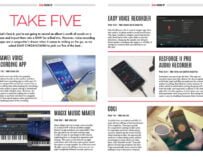
Jordan Rudess explains the ‘Circle of 5ths’ exercise on the Pyramind book’s accompanying DVD
A new producer-focused training textbook and accompanying DVD on workflow techniques needed for effectively creating, composing and recording music projects

 ne of a nine-part Pro Audio series from Alfred Publishing, covering creative, technical and business disciplines, this Pyramind training book looks at workflow techniques necessary for effectively producing, composing and recording music projects. Focusing on music theory, songwriting and piano, this is a solid A4-sized textbook with over 220 pages and includes a DVD of video demonstrations and accompanying audio files, which justifies its training material price tag ($39.99 RRP).
ne of a nine-part Pro Audio series from Alfred Publishing, covering creative, technical and business disciplines, this Pyramind training book looks at workflow techniques necessary for effectively producing, composing and recording music projects. Focusing on music theory, songwriting and piano, this is a solid A4-sized textbook with over 220 pages and includes a DVD of video demonstrations and accompanying audio files, which justifies its training material price tag ($39.99 RRP).
For us, the key message was clear that songwriting plays only a very small part in this particular training scheme, but how little? And does the theory and production workflow offer anything new to the songwriter?
Well, as it explains in the preface, the writers have aimed this squarely at producers, so traditional technophobic songwriters should probably steer clear. However, it’s ideal for those wanting to get to grips with their home studio and, if you’re aiming to join the new breed of successful writer-producers like Mark Ronson and Calvin Harris, this could be the perfect option to improve in both areas.
Across eight comprehensive sections, the Music Theory… book looks in detail at the many facets of rhythm, scales, triads and modes, regularly employing clear diagrams, tips and exercises along the way. In particular, Coach’s Corner box-outs offer plenty of quick insights and tricks, with the accompanying DVD being used to good effect.
As well as the relevant audio files providing further explanation of each point, the disc also contains video demonstrations from Pyramind’s Matt Donner, pianist Linda Arnold (AKA recording artist Divasonic) and virtuoso keyboard player Jordan Rudess, who all present music theory and piano exercises such as the Circle Of 5ths and I-IV-V rhythmic practice. The piano playing techniques start at a very basic level, but the clear presentational techniques used, such as split-screen and point-of-view camera angles, mean this is perfect for the novice musician who wants to quickly understand the instrument and use it as a songwriting tool.
As Matt Donner explains in the DVD’s welcome message, “theory is empty unless you use it in your music. The more you know, the more creative you can be, and the faster you can get from idea to execution, to hearing the music come back to the way you really want it.”
Verdict: Although very production-oriented, this is a useful, comprehensive guide to music theory for songwriters of all abilities
![]()
![]()
![]()
![]()
![]()
Alex Miles





































Related Articles